Last updated: February 22, 2024
Article
“Girls” in Uniform
Yellowstone National Park’s Superintendent Horace M. Albright was one of a few superintendents hiring women park rangers in the 1920s. Unlike W.B. Lewis at Yosemite, Albright didn’t use his superintendent’s discretion to exempt women rangers from the NPS uniform. In a 1978 oral history interview, he recalled that he “took a lot of good-natured joking” from other superintendents because the NPS had “never had girls doing work like this, never had girls in uniform.”
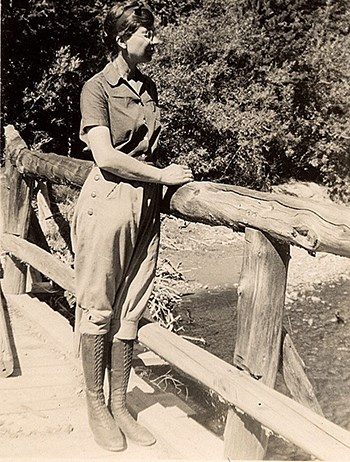
Designing Women
In his book National Park Service Uniforms: Breeches, Blouses, and Skirts, 1918-1991, R. Bryce Workman states that “the National Park Service had no provisions, uniform or otherwise, for women.” He concludes, “Consequently, they were left, pretty much, to their own devices as to what they were to wear.” However, our comparison of published and unpublished family photographs and those available in NPS archives with the uniform regulations have brought new clarity to the issue for Yellowstone’s women rangers, just as The Authority of the Badge did for Yosemite’s women. Using previously unseen photographs provided by Marguerite Lindsley Arnold’s family, we can finally lay The Myth of the Men’s Uniform to rest.
In addition, we can end speculation by many authors that women like Marguerite Lindsley and Frances Eva Pound designed their own uniforms because the NPS didn’t have a “women’s uniform.” What many see as contradictory information or perhaps even evidence of the women’s independent spirits or frustration is, in fact, entirely consistent with the NPS uniform regulations at the time.
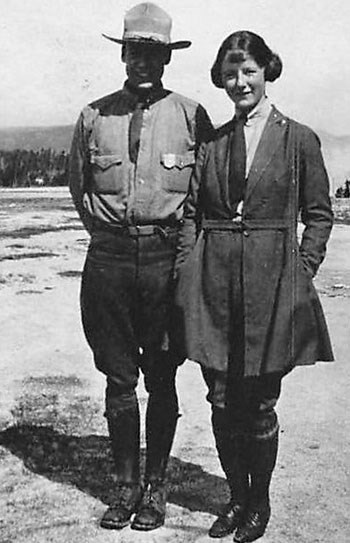
The “Prescribed” Uniform
From 1920 to 1922, temporary rangers were not required to wear the standard uniform. Instead, the uniform regulations included a “prescribed temporary ranger uniform” that consisted of riding breeches, puttees (leather wrap-around shin guards), shoes, gray wool shirt, dark green tie, Stetson hat, USNPS collar ornaments, and the temporary ranger sleeve insignia or brassard.
There are no confirmed photographs of rangers Isabel Bassett Wasson (1920) and Mary A. Rolfe (1921) taken on duty at Yellowstone. It’s highly unlikely that Wasson wore the standard uniform, which was only approved four months before she began her position at the park. Given how new it was, she may have worn either the prescribed temporary ranger outfit or even civilian clothing. Rolfe, however, worked the same year as Marguerite Lindsley’s first season (1921–1923, 1926–1931), and it’s reasonable to assume that she dressed in a similar manner to Lindsley—if only because Superintendent Albright was a strong advocate for wearing NPS uniforms and presenting a consistent “ranger look” to visitors.
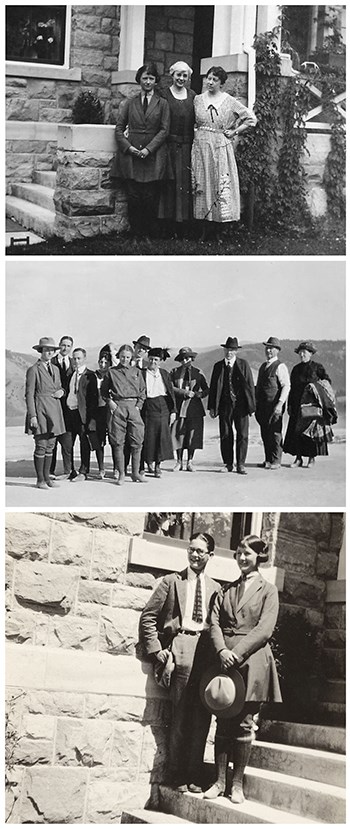
Several family photos from the early 1920s show Lindsley wearing a collared gray shirt, dark necktie, shoes, and Stetson hat. Although she isn’t wearing puttees, her clothes are a good match to those prescribed for temporary rangers before 1923. One photo is tentatively dated to 1921 (due to smeared ink), but another is clearly marked 1922 on the back. These photo demonstrate that Lindsley was, in fact, following the uniform regulations for a temporary ranger.
But that’s not a park ranger coat, right? Right. Before 1923 the uniform regulations don’t mention coats for temporary rangers, yet Yellowstone’s rangers would have needed coats even in summer. Her belted coat appears to be the same one she wears in family photos from about 1918, before she worked for the NPS. In other words, as a temporary ranger she simply wore a coat she already had. That’s not unexpected or even a violation of the uniform regulations, as they are silent on coats for temporary rangers. She likely had Albright’s approval to wear it. The photos demonstrate it was worn more than once or twice and was a consistent part of her uniform.
One final point of interest is that Lindsley doesn’t appear to be wearing USNPS collar ornaments, sleeve insignia, or a ranger badge. In keeping with the regulations, she should be wearing all three. The 1922 photo may have a hint of the collar insignia on her left shoulder, but the others do not. In the case of the badge, she might not have been issued one, either because she was a woman or because of a known shortage of badges at the time. She could also be wearing it on her shirt instead of her coat. Although she isn’t wearing the round sleeve insignia in these photos, she does have one later as a permanent ranger.
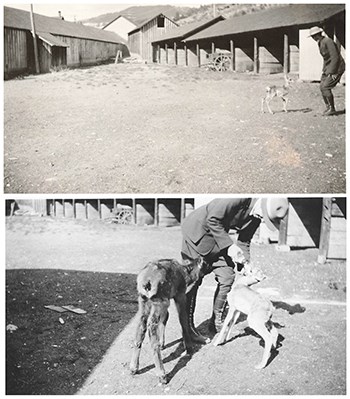
The “Standard” Uniform
Beginning in 1923 temporary rangers everywhere had to wear the standard NPS uniform. Given that photos demonstrate that three or four of the six women rangers after that date were uniformed, it’s reasonable to assume that all of Yellowstone’s women rangers wore either the standard uniform or had approved exceptions for modifications to it. Although no on-duty images of Margaret Thone (1924–1925) are known, there are photographs of several other women rangers in uniforms.
Two previously unpublished images from Marguerite Lindsley Arnold’s archives depict a woman ranger wearing the standard uniform. In one photo, her badge is visible on the coat. But who is this mystery women? Thone worked during the two years that Lindsley did not. Although Lindsley lived and guided in the park those same years, she would be less like to have photos in her personal collection of a woman she didn’t work with. Irene Wisdom (1924–1930) is a possibility, but she would have been in her 30s at the time, which is older than the woman appears.
The boots in the photos don’t match those worn by Lindsley, Nelson, or Frances Pound. Based on the remaining women’s ages and the apparent youth of the women in the photo, the assumption is that she is either Elizabeth Conard (aged 22 in 1926) or Virginia Pound (age 19 in 1927).
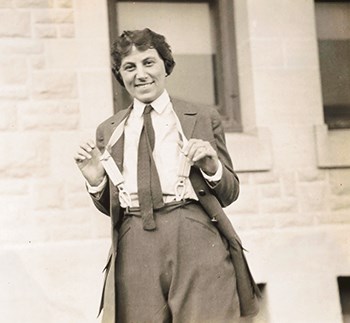
An outside possibility is also Herma Albertson, a temporary ranger-naturalist from 1929 before she became the NPS’ first permanent naturalist in 1931. She’s not a great fit, though, as she was 33 years old in 1929, and she wore boots with her uniform that were like those of Lindsley, Nelson, and Frances Pound (not to mention a better-fitting uniform). However, an image of her in civilian clothes includes similar boots, so she can’t be ruled out at this stage. Is there another clue in these photos to help date them? Maybe!
Lindsley cared for many orphaned animals during her years at Yellowstone. In 1926, she took in an antelope fawn she named “Jimmie.” Photos of her feeding Jimmie put him about the same size as the fawn in the top photo as well as the one being fed in the bottom image. We’re not experts in antelope facial recognition, but he looks like Jimmie to us. If it is him, then these images would date to 1926, and the woman would be Conard. Conclusive? No, but certainly possible. Even if he isn’t Jimmie, she is a ranger wearing a standard uniform.
Back on firmer ground, there are several images of Ranger Frieda B. Nelson (1925–1926) in uniform. She wore the standard NPS uniform with the coat buttoned right to left, an adaptation for women. Even still, she needed suspenders to keep her pants up!
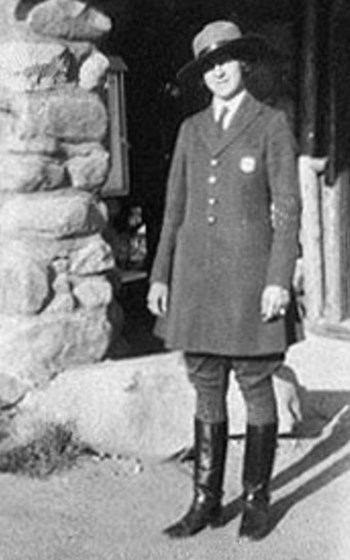
A handful of images of Frances Eva Pound (1926–1929) in uniform are also known. Her uniform is interesting because the cut of her coat is different than that of the standard uniform. Some authors have used this to document that Pound created her own uniform. As Nelson and others show, Yellowstone’s other temporary women rangers wore the standard uniform. It’s unclear why Pound chose not to, but in a 1997 oral history interview she recounts that the design was inspired by Lindsley’s coat. We now can document that it was modeled on Lindsley’s permanent ranger uniform, which is what she would have been wearing when Pound was hired.
Pound also recounted that her mother and Grace Albright (wife of Superintendent Horace M. Albright) created the pattern for her 1926 coat. Although it has a similar A-line shape to Lindsley’s coat, it has more buttons, and the lapels are more in keeping with the standard uniform coat. Surely Mrs. Albright wouldn’t have been designing “knock off” uniform coats without her husband’s approval. More concretely, in 1997 Pound remembered that the design was approved by NPS Director Stephen T. Mather himself. Her uniform, then, was not only an approved exception to the uniform regulations but, as such, was completely consistent with them.
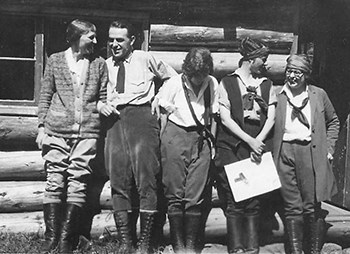
Before we turn to Lindsley’s uniform as a permanent ranger, we’ve got another thought to share about the temporary rangers. We find it surprising that there aren’t group photos of the women rangers in uniform. While we know some of them worked in different areas of the park, we also know that parks loved to take group photos of their ranger forces. While we haven’t found any formal group shots, there are a few in the Arnold family archives that may show some of the women together in their down time. Unfortunately, none identify the women or have dates, so this is speculative at best.
Having said that, we are intrigued by the photo on the left. Lindsley is second from the right and clearly not in uniform. But notice what the woman on the far right is wearing! That coat looks strikingly like the one worn by Lindsley as a permanent ranger and which inspired Frances Pound’s coat.
Both women on either side of Lindsley wear white blouses open at the neck with kerchiefs instead of ties. As we’ll see when we look at Lindsley’s later uniform, she sometimes wore that type of shirt as a permanent ranger. The pockets on the breeches worn by the woman to the left of Lindsley also look similar to those worn by Nelson (although the lack of suspenders suggest it isn’t her!). As for the other two in the photo, could that be Irene Wisdom and her ranger husband Tex on the left? In 1926 Yellowstone had five women rangers. Could this photo represent four of them?
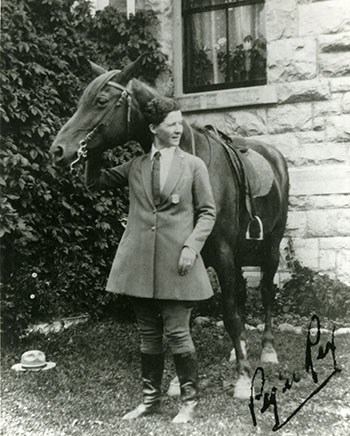
A Permanent Woman Ranger
Just as new research clarified Lindsley temporary park ranger uniform, her permanent ranger uniform is now also better dated and understood, thanks again largely to never-before-seen photographs in the Arnold family archives.
With some additional research (and more help from our animal friends), we can also better date a known photo of her. The “Peg and Rex” image is well known and previously dated to about 1925. We know that’s not correct as she didn’t work for the NPS until December that year (and that does not look like Yellowstone in December!). We also know it doesn’t mesh with her prescribed temporary uniform. As a result, it can’t be earlier than 1926. But does Rex have anything to say about that? Lindsley had her own horse named Tuey. According to Bill Arnold, Rex belonged to his father (and Lindsley’s future husband), Ben Arnold. He began working at the park in June 1927. It’s reasonable to assume, therefore, that a photo of her with Rex must be later than that date.

Although we can’t say that Mather approved Lindsley’s uniform coat as he did for Frances Pound, it’s safe to say that Albright, as the park’s superintendent did. There are a number of photos of Lindsley in the same uniform coat, worn with the collared shirt and tie. However, there are also several photos of her wearing her uniform and badge with white shirt, worn open at the neck. Remember that group photo of the mystery women we talked about? Lindsley doesn’t wear the kerchief in any of these, but the resemblance is still striking. Can that really be coincidence?
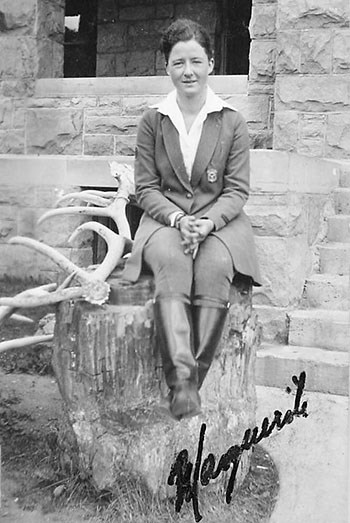
There are two likely explanations for the shirt. The first is that it was worn simply for publicity photos. At least two magazines did profiles on her in 1927. All of the known images date to August 18, 1927, and look posed. It wouldn’t be the first time that a magazine asked for a clothing change like removing a necktie to “soften” a woman’s look.
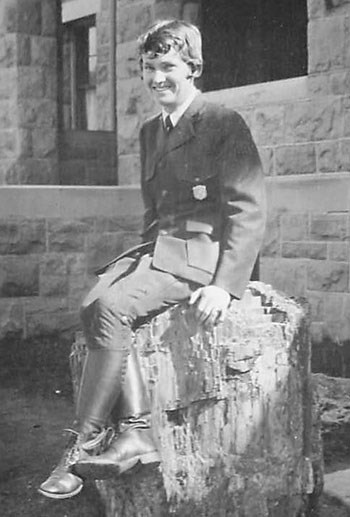
The other possibility is that in mid-1927 Yellowstone made a local exception to its uniform to allow the open shirt without a tie. Could this have been a deliberate attempt to change the look of the women in response to recommendations that the NPS no longer hire women rangers? Was the white shirt and lack of tie a way of Protecting the Ranger Image? After all, 1927 was a pivotal year for that issue, and we can document that as of March 1927 she wore the uniform shirt and tie. Yet, by August, there is a different look, even though she continues to wear a ranger badge. Was it an attempt to distinguish women like Lindsley (and our mystery women in the group photo) who were doing education work from Frances Pound doing more traditional “ranger work?” Speaking of our mystery women, if this theory holds true, then their identities also shift. In 1927, only Lindsley, Frances Pound, her sister Virginia Pound, and Irene Wisdom were on the ranger staff.
When Herma Albertson was hired as a ranger-naturalist (not a park ranger) in 1929, she wore the standard uniform until she resigned in 1933. Without more photographs of Lindsley (and Frances Pound and Irene Wisdom for that matter), we may never know if wearing the white blouse instead of the gray shirt and tie was a real change or just a temporary “blip” at Yellowstone. Just a year after the “photo shoot” images were taken in 1927, Lindsley gave up her permanent job to marry Everett LeRoy “Ben” Arnold. Frances Pound’s position ended in 1929 and Wisdom’s in 1930. In 1931, Lindsley Arnold resigned from the NPS as well. It would be decades before women rangers were hired again at Yellowstone.

A Coat of Many Colors?
If you’ve made it this far, thanks for hanging in there with us! We can’t leave the discussion of what Yellowstone’s early women rangers wore without addressing one (or two!) more myths. In his book National Park Service Uniforms: Breeches, Blouses, and Skirts, 1918-1991, R. Bryce Workman wrote that the “hunting coat” Peg wore was “probably red.” We just can’t let that one stand. Official NPS uniforms have pretty much always been “green and gray.” (Yes, we’re deliberately ignoring the 1970s for the moment! You’ll find that elsewhere in the Portfolio, we promise).
So why would Workman suggest her coat in the “Peg and Rex” photo was red? We don’t know for sure because he doesn’t provide any evidence for the claim. It may just simply stem from his description of her riding coat as a “hunting coat” (think English hunters on horses chasing after hounds and foxes).
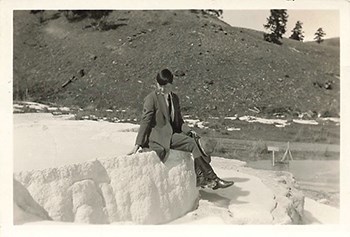
While there is no evidence that the coat was red, there is plenty that it was green. A Christian Science Monitor profile of Lindsley from 1927 refers to her “olive-green uniform.” A Sunset Magazine article from November that same year, titled “She Is a Real Ranger,” notes that she wore the permanent ranger brassard on her uniform sleeve. It goes on to describe her “wearing with grace her tailor-made forestry-green whipcord uniform.”
Moreover, Superintendent (and NPS Assistant Director, Field) Horace M. Albright, himself a proponent of the NPS uniform and presenting a consistent image to the public, surely wouldn’t have allowed her to wear a red hunting coat as part of her uniform as either a temporary or permanent ranger. Other women rangers at the park at the same time as Lindsley wore green uniforms that further underscore the point.
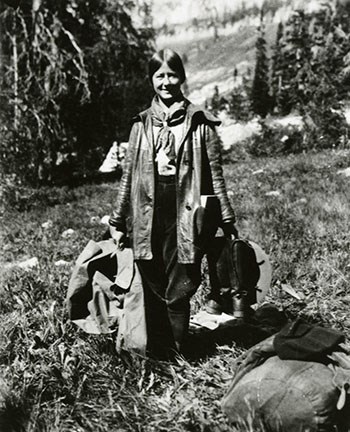
Indeed, in 1978 Albright recalled that Lindsley “wore the full uniform all the time. The jacket and all, she never took that uniform off. And she wore boots. You know, in those days, the rangers all wore boots . . .” Throughout the interview, however, Albright recalled several women rangers who wore the NPS uniform, remembering nothing unusual about any of their clothes. In a September 1962 interview, Herma Albertson Baggley described Lindsley as “my ideal of a woman in uniform” and saying, “She was one of the most beautiful women in a uniform that I have ever seen.”
Albright’s description of her wearing the uniform all the time also contradicts Workman’s statement that Lindsley didn’t wear her uniform often. His statement isn't supported by the additional images of Lindsley shown here. Other photos in the Arnold family collection further support the need to correct such misinformation. Like uniformed employees today, and as both a temporary and permanent ranger, Lindsley wore her NPS uniform regularly and with pride.
Yellowstone’s women are notable for much more than their clothes, but it’s important to correct the record and restore the NPS standard uniform to these early rangers. Suggestions that they wore whatever they wanted or designed their own uniforms outside of the uniform regulations are based on the incorrect belief that the standard NPS uniform was for men only. It’s a myth that lead many to believe that the “new” women’s uniform in 1943 was a step forward for women, rather than arguably a step back.
Explore More!
To learn more about Women and the NPS Uniform, visit Dressing the Part: A Portfolio of Women's History in the NPS.
